Tiny-house living fascinates Breanndán Ó Beaglaoich, though it is more by accident than design.
His own tigín in west Kerry’s Baile na bPoc bears all the craftsmanship of a master boatbuilder. In fact, a Dingle man who knows his bow from his stern helped to construct the 68sq m (730sq ft) dwelling.
With timber walls and slate roof, it may not quite float – yet – but it does move. The passive house – with living and bedrooms, kitchen and loft – was constructed on the chassis of an articulated lorry. Nestled in a glen under mighty Mount Brandon, it blends into the landscape and is camouflaged from the road.
“I never think of the mountain as anything but Cnoc Bréanainn,” Ó Beaglaoich says, reciting the names of streams, fields, townlands in his paróiste na Módhrach, or parish of the Norman Moores.
He loves the language now, but didn’t always feel that way, recalling a sense of shame instilled by parents who felt their children would never survive with only Irish. He recently heard a neighbour talk of “an abha dhoircheacht idir lá agus oíche trathnóna”, as in the darkening time between day, evening and night. He thought it was the most beautiful description of dusk he had ever heard.
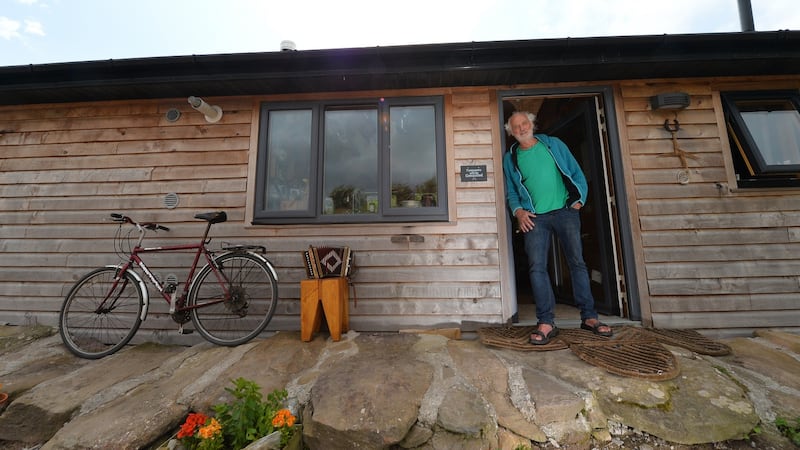
Twilight zone
Now, however, Ó Beaglaoich is caught in a similar twilight zone, a “darkening time”, having received an enforcement notice to quit from Kerry County Council.
The musician had originally lived in a stone house built in his home parish, where he and his wife reared four children. When the marriage broke up, he sought planning permission to build another home in 2006. He was advised to include a copy of his separation agreement in his planning application. He also included a letter from the parish priest, vouching that he was from the area and had attended local schools.
Three engineers and much correspondence later, he cannot understand why he has been unsuccessful. Refused by Kerry County Council, his appeal to An Bord Pleanála resulted in approval with conditions by an inspector. However, the appeals board didn’t accepts its own official’s recommendation, and refused permission.
Through his music, Ó Beaglaoich is an integral part of the Kerry Gaeltacht and, he felt, he had demonstrated housing need. At a meeting last January, he was advised to look for a suitable old house or barn.
“During that research, I confirmed that 235 people had lived in this village before the great Famine, and there were always at least 28 to 30 people living in Baile na bPoc in the 1960s and 1970s when I was growing up,”he says. “There might only be up to a dozen here now.”
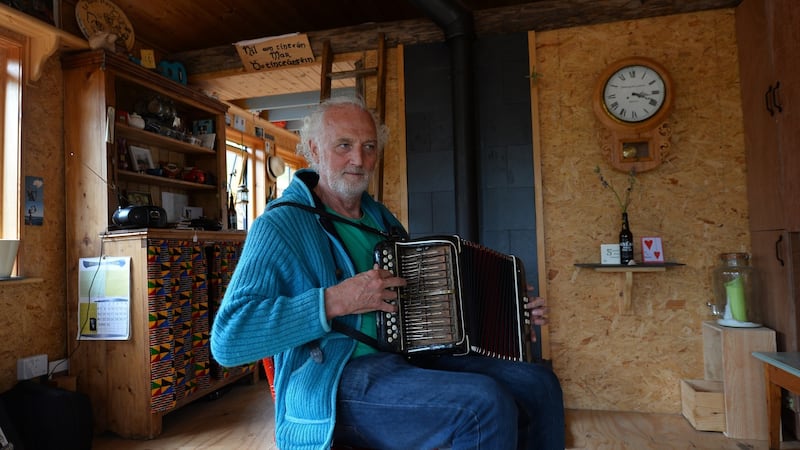
No consistency
Comparing notes with others, he realised there seemed to be no consistency in decisions, and he also noticed that other buildings – some new, several storeys high and obscuring the view of the mountain – were being approved around him.
“I’ve nothing against strict regulations, if evenly applied,” he says. “But it seems as if tourism takes precedence over people. How will the tourists want to come if no one lives here anymore?”
He was loath to try the political route, and supports the concept of curtailing councillors’ powers in relation to planning. However, one local representative contacted Ó Beaglaoich and told him that he could have “saved him a lot of money”. The county council “never intended” to give him planning approval, the politician told him.
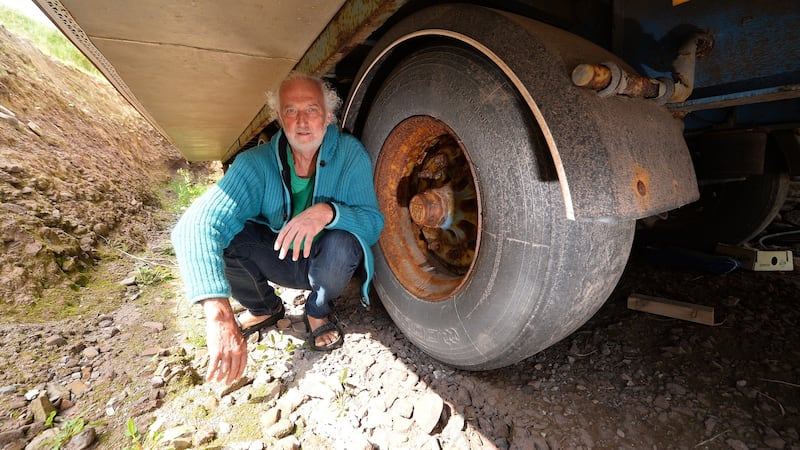
In 2015, he decided his best course of action was to focus on an option which would not require it at all. He built his tigín on wheels for €50,0004, connected it to a well, installed a dry “eco toilet”, and spent just €40 on heating over the last winter. It took all of a month to construct. However, Kerry County Council sent him an enforcement notice.
The same politician told him to “keep my head down, and my mouth shut and they might turn a blind eye”. Ó Beaglaoich was dismayed at the suggestion, and says he feels this approach fails to tackle a far wider issue.
“ I have four children and it would seem as if none of them are allowed to live in the village I was born and raised in,” he says. “My brother has four children also and his four children are in the same boat and he has 100 acres of land. Even in the time of the British, we were allowed to live in our home villages !”
Serious illness
Ó Beaglaoich’s sister Bríde had a similar unsuccessful battle. She had been living in Limerick, but wanted to return home after she recovered from a serious illness. A site was offered to her by a man who had bought the land from her father in the 1970s. He had secured planning permission, but never activated it.
“I had a meeting with a planning officer in Dingle about 15 years ago, and the officer informed me of a personal preference to turn west Kerry into a national park. Some years later, I had a pre-planning consultation and was told that I would get permission if I built across the road from my site,” Ní Bheaglaoich recalls.
“I pointed out I didn’t own that site. I was then told that because I owned a house in Limerick, I wouldn’t get permission. I explained I was selling this house and had been very ill. I said I just wanted to build a small traditional cottage, but that didn’t seem to make a difference,”she says.
“I’m going to try again next year, but it seems crazy that there is no recognition that native Irish speakers, who would have children and grandchildren speaking Irish, would want to return to the area at a time when all the talk is of rural decline,” she says.
Mairtín Bealín is a Fáílte Ireland “food ambassador” and proprietor of Dingle’s award-winning Global Village restaurant. He was restoring an old stone house, but the approvals took an exhausting five years. He is critical of a “lack of consistency” in the planning department.
Detailed template
“I hear the same stories over and over again here, and there isn’t a detailed template that people can study,” he says. He says this inconsistency is already contributing to a looming crisis in accommodation.
“The Government wants tourism development, but restrictions on locals building and the fact that so many people now rent rooms out on Airbnb means that those working in the service industry in west Kerry are finding it more and more difficult to secure somewhere to live,” he says.
Ann Reilly is a natural healer who has been living in Annascaul for the past 17 years.
“So you can tell from my [north American] accent that I am not from here, but my grandparents were from Annascaul,” she says.
Some 12 years ago, she had discussions with the planning office about building a home in a field registered in the name of close relatives, and was told there was no good reason why not.
“It took me while to get the field registered in my name, but then I went to a pre-planning meeting with a different planner, who advised that it would be possible to build if I met three different criteria,” Ms Reilly recalls.
“I spent about €6,000, I put the planning application in, and was refused on grounds of visual obstruction to tourists,” she says. “This was going to be a single-storey house, and there are farm buildings closer to the mountain which are bigger than it would have been.”
Not important
She was told at one point that she “wasn’t important enough to the area” as she “wasn’t Paudie O’Shea”, but persisted. She sought the advice of a local politician, who informed her he had heard on good authority that she was never ever going to get planning approval.
“I think what upsets me is that the planner had been so positive at our first meeting, kept me hanging for a number of years, cost me a lot of money and then turned me down,” she says. Like Ó Beaglaoich, she witnessed other homes being built in the same area, and began to feel that this was “not a level playing field”.
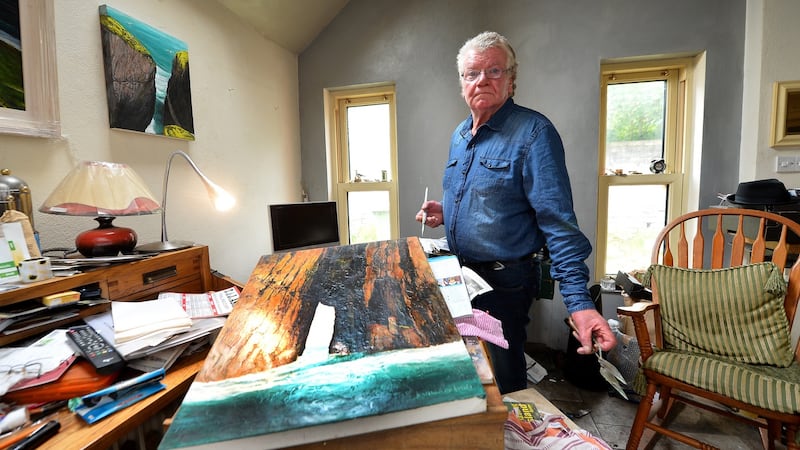
Artist Tomás Ó Cíobháin was born in west Kerry’s Gráig and sought planning permission to build there, having a demonstrable link to the area. He spent eight years seeking approval, and was unsuccessful.
“One of the issues raised with me at a planning meeting was access, and yet there is already access to the site and it is being used by three houses,” he says.
“The planner told me at one point that I could use three old buildings and convert them to a house, but these were buildings owned by my brother,” he says.
Ó Cíobháin bought the old post office in Ballyferriter, but it was not his first choice – and is an expensive project to refurbish.
“Even with that, there are restrictions,” he says. “You would think they would want local people with the language to live in an area, but it seems that is not the case.”
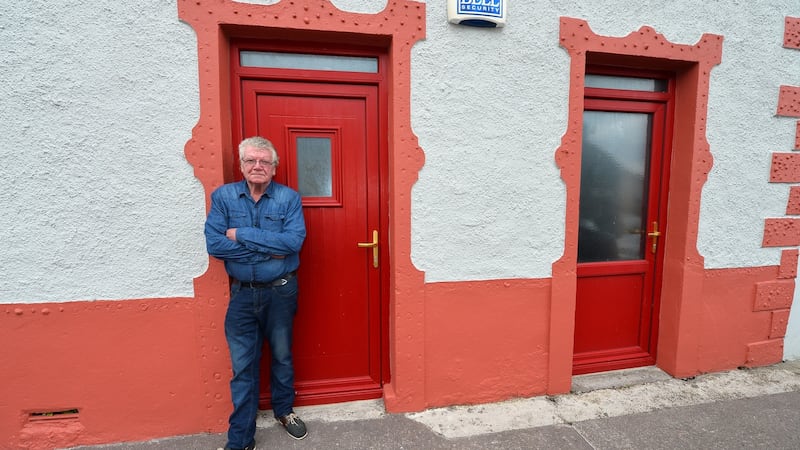
From the area
Under current planning guidelines for rural dwellings, applicants must be from the area or long-term residents. However, landowners wishing to build a first home for permanent occupation by their children must demonstrate that it is their principal family residence where they have lived for a minimum of seven years.
Other potential applicants may qualify if they have been employed in a “rural-based activity”, but have to be engaged in this employment for over five years. The guidelines are intended to protect any houses being built, supposedly for family needs, and then sold on.
A 2013 European Court of Justice ruling, which Sligo councillor Michael Clark has recently highlighted, appears to challenge the priority given to bloodlines. It found that planning restrictions to protect the Flemish language and culture constituted an unjustified restriction on fundamental freedoms.
Minister for Housing Simon Coveney recently told the Dáíl that his department was engaging with the European Commission, with a view to issuing updated guidelines to planning authorities.
However, in west Kerry, there is a perception that its local authority is taking the opposite approach to Flanders. Dara Ó Cinnéide should have been on a permanent high when he captained Kerry to the all-Ireland GAA football title in 2004, but remembers it was also a time when he was struggling to get permission for his own home in Baile na hAbha, close to where his parents live.
“I tried to do things responsibly, employed an architect, tried to design for low impact with a geothermal heating system, but there was never any clear definition as to what would meet the ‘traditional house’ requirements, and a sense that the planners had a preoccupation with impact on tourist routes,” Ó Cinnéide recalls.
“There were small things, like being told I hadn’t done a percolation test, when I had, or being asked to move 30 metres to the south-southwest where I’d be in the middle of a stream,” he recalls.
Holiday homes
“I have four kids and a friend of mine also seeking to build nearby has three kids, so they should be actively encouraging us,”he says. “Instead, we would see holiday homes going up around us.”
“There were 75 to 80 pupils at school when I was there, but only 40 or so now. I have a relative involved in fish processing who is an employer, and he is similarly frustrated,” Ó Cinnéide says. “To this day, I don’t know how I actually got planning at all. There is a lot of fog, and one has to be able and prepared to spend a lot of money before knowing if one will get approval at all . . .”
Singer Mary Black says she admires and respect the council’s desire to protect the landscape but believes it is “vital” to allow for communities to live there too.
Black had been spending holidays in the west Kerry area for years, and then secured planning permission for a house in Baile Breac just a mile from Ó Beaglaoich.
“Obviously, no one wants monstrosities built, but the basic needs of the local people should be looked after first,”she says. “When a man like Breanndán just wants to live out the rest of his life here, surely that should be encouraged.”
Musician Shaun Davey is not from Kerry, but might as well be, as composer of the Brendan Voyage orchestral suite depicting adventurer Tim Severin’s departure by currach in the wake of St Brendan from west Kerry.
Davey fell in love with an empty two-storey farmhouse in paróiste na Modhrach, close to Ó Beaglaoich’s homestead, some years ago, and restored it for living. However, he is now putting the house on the market, and explains that this is due to a “perception that we couldn’t get permission to build a studio where we could work”.
Studio
A stone-cut barn had existed on the farmhouse site, but was knocked some time ago for its material. Davey hoped to construct a studio in keeping with the barn’s design.
“Given the experience of my neighbours with planning, I didn’t push it,” Davey says.
Davey concurs with the concept of encouraging “clustering” on the clachan settlement model, but says there is a strong perception of lack of consistency by planners.
“We have been in Kerry for about 15 years, and we see things built that are aesthetically wrong, but that’s a separate issue from friends and neighbours being able to accommodate the next generation – and we hear of the struggles,” he says. “Breanndán Ó Beaglaoich and his siblings are cultural royalty, but if they can’t stay here, then the music goes.”
Retired marine engineer John Holstead observes that planning legislation which doesn’t match reality is a form of deprivation. There are those who already believe there is a “gentrification” of some of the most beautiful parts of the coast for this reason, as meeting planning guidelines can cost large amounts of money.
Holstead has a panoramic view of the Atlantic through the bay window of his converted mobile home at Cuan pier caravan park, near Ventry. He spent two years designing, researching and sourcing materials for his dwelling, which is made of reinforced fibre concrete slabs.
Art gallery
White walls and cobalt blue floor tiles make for a space that resembles an art gallery – and Holstead has applied his skill as a sculptor. He has created a mayfly, a flagon of wine, and a teapot and cups to conceal light fittings on his walls.
His timber roof is lined with a rubber membrane, and the ceiling is made of white fabric from France. He has gas central heating, and his carbon footprint is low.
“I rent the site, so I am here on the same basis as most of the privately owned mobile homes, some up to 35 years old,” Holstead says. “I wanted to live in this space of my own design, but had I needed to apply for planning permission they would never have given it to me.”
He believes if people do not have the freedom to put a roof over their heads that meets their needs – and is within their means – it leads to homelessness.
“Living in a shanty town would be better than that,” he says.
“Professional architects must tear their hair out constantly, as there is no allowance for freedom or creativity, unless the client is very rich,” he observes.
An Taisce’s view is that disparate development associated with one-off housing sucks the life out of towns and villages, which are in turn being drained by low-cost supermarkets built on the outskirts to suit the car.
An Taisce’s planning representative for Kerry, Catherine McMullin, says that generally the planners are “fair”, and most applicants tend to stay within the guidelines – hence An Taisce has not objected to an application in a rural area for some years, she says.
Kerry County Council says it does not comment on individual cases, but says “the allegation that the planning process is constantly depriving applicants from getting planning permission for dwellings in rural areas does not reflect the position on the ground”.
Visual amenity
It says it granted permission for 193 out of 216 applications for one-off rural housing in 2016, and says the remaining 23 applications were refused for a number of reasons including “ traffic, visual amenity, effluent disposal and lack of local need”.
“The corresponding figures for 2015 were 175 grants and 19 refusals,” it says.
The local authority says it has a “very detailed and comprehensive design guide to assist people and architect/agents seeking to construct a dwelling in a rural area”, published in 2009.
It says its rural settlement policy “aims to sustain vibrant rural communities, while having regard to character of the landscape and the local environment”.
“Rural decline is a complex socio-economic issue requiring policy initiatives across a range of areas. Repeated Census data indicates that there are substantial vacant properties in rural areas and that the availability of accommodation in itself does not guarantee sustainability of rural areas,” it says.
On May 26th, Ó Beaglaoich was among fellow artists invited to Muckross House, Killarney to hear the Taoiseach, Enda Kenny, enthuse about a Kerry “activation plan” as part of the Creative Ireland initiative for the arts.
He should have felt like bursting into music and song. Instead, he came home to his tigín with a heavy heart.











